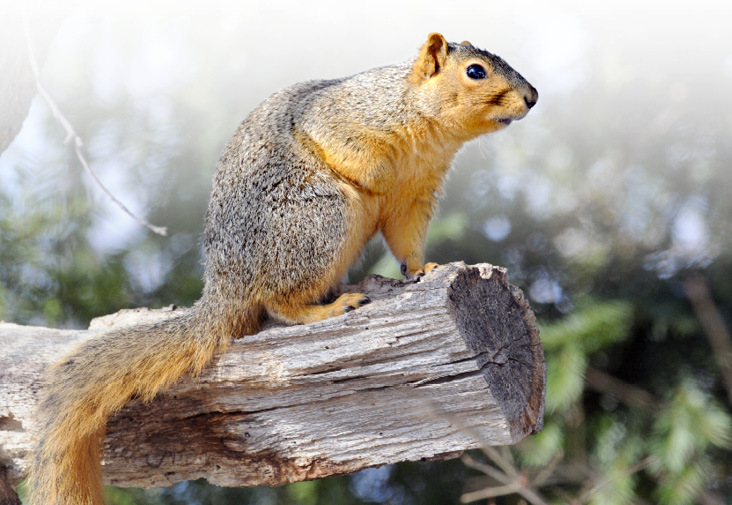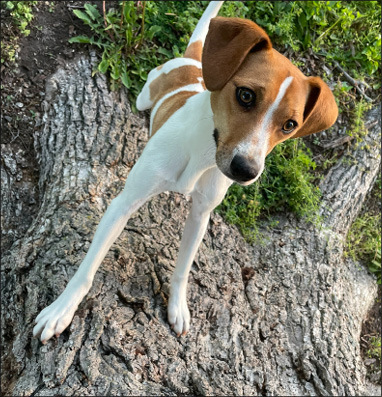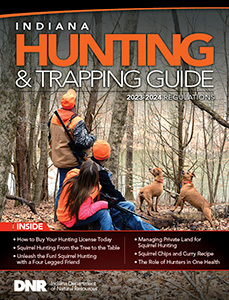Squirrel Hunting
Squirrel Hunting: From the Tree to the Table

In the age of social media and the big photo-worthy bucks that deer hunters love to post about, squirrel hunting can be overlooked.
But there’s nothing more enjoyable than slowly walking through the woods, pausing from time to time, and looking for the slightest movements in the treetops for squirrels.
I have hunted for the past 10 years and developed a love for hunting squirrels above all other species. This passion has led me to talk with other avid hunters throughout the state. I’ve found out that many hunters learned how to hunt squirrels before graduating to larger game.
Bloomington’s Cory Lamping is one example. He enjoys squirrel hunting because it is easily accessible, fun, and engaging. Cory’s father introduced him to hunting by teaching him to hunt squirrels. When Cory returned to hunting as an adult, he started with squirrels. Other hunters said they appreciate squirrel hunting for the lifelong lessons it’s taught them—patience, stealth, and woodsmanship.
Woodsmanship is a hunter’s essential knowledge of the species they pursue, such as where to find it, what it eats, and where it lives. Woodsmanship is not just about knowing species facts—it also involves mastering the ability to move through the woods in a thoughtful manner and approaching animals without detection. These skills, along with marksmanship, improve the more times you hunt squirrel.
Squirrels can be hunted in many ways and with a variety of equipment. You can legally take squirrel with firearms such as a .410, a 12- or 20-gauge shotgun, or .22 rifle. If you’re a new hunter who hasn’t sharpened your marksmanship skills, you might choose a shotgun or .410, which offer better chances of contact, as opposed to a .22, which requires high shooting proficiency. In addition to firearms, you can also hunt squirrels with archery equipment by changing out a normal deer broadhead for a smaller version, or by switching to a blunt point, which is a tip that won’t stick in trees or burrow under the weeds of the forest floor.
Other than your preferred method of take and the proper ammunition, hunting squirrel requires nothing fancy. You don’t need head-to-toe camouflage clothing, nor do you need high-tech gadgets to find squirrels. You don’t have to use a blind or a rangefinder, and you don’t need much muscle to carry your harvest. You might consider bringing a set of binoculars to see distant squirrels more easily, as well as a vest with a pouch in the back to carry your squirrels and keep your hands free, but neither is necessary to have a great day outdoors chasing squirrels.
Some people may turn up their noses when they imagine eating squirrels, but squirrel hunters will tell you that if you don’t give squirrel meat a chance, you’re missing out. There are many ways to prepare it, such as squirrel and noodles, squirrel and gravy, and chicken-fried squirrel. It can be baked, deep-fried, and even grilled. Just about any method you would use to prepare chicken wings, you can use with a squirrel. One of my favorites is dropping squirrel meat into a pressure cooker for about 15 minutes and adding water, salt, and pepper.
But no matter how you cook it, you can’t go wrong with squirrel meat!
Squirrel Hunting: A Timeless Tradition
As a young man in the early 1960s, my dad and his best friend planned their fall days around adventures in the woods.
They would meet in the evenings after work to plan where they would go the next day. They were squirrel hunters, and that was all they thought about from opening day until the season’s final stretch of daylight.
I have seen my dad’s passion for the sport firsthand. He kept returning to the woods, not for a lack of other entertainment, but because hunting was his passion. A passion that I can’t help but carry on even though I started hunting just 10 years ago.
My father is 82 now, but a few years ago, when he was 78, I invited him to spend a morning chasing fox squirrels with me. With some gentle encouragement, he agreed. It had been a long while since he had gone hunting, but he showed up with the same squirrel gun he used as a teenager—a few shots at a target proved that rifle was still as true as it had ever been.
That day I watched him tread through the woods in search of squirrels, no doubt moving much more slowly than the last time he set out with his old .22, but with the same passion and intention I imagined he had as a young man.
We took just one squirrel that morning, but that was the least important part of our experience. Sitting on a log and hearing his stories about squirrel hunting more than 50 years ago and nodding my head in agreement when he spoke of the joy those experiences brought him reminded me that some things are timeless.
Bonding over squirrel hunting brought my dad and me closer, and it never would have happened if he hadn’t joined me that day.
As this year’s hunting seasons begin, I encourage you to take part in the enduring tradition of hunting to create bonds with your loved ones that can be just as timeless as mine.
Unleash the Fun! Squirrel Hunting with a Four Legged Friend

The cool breeze pushes me toward the big oak I’ve propped myself against, inspiring thoughts of the biscuits and gravy calling my name at the local diner. I let my eyes drift across the woods, pausing to watch a downy woodpecker’s frenzied hops up and down the trunk of another oak a few yards away. Suddenly the sounds of barks and whines pierce my relative calm—Bob Fudge, my treeing feist pup, has treed a squirrel by himself!
I frantically weave through the trees, following Bob’s calls, until I reach him. He stares upward, bites at the shaggy bark, and tries to climb to the squirrel. I set my sights, take a breath, and squeeze the trigger.
Looks like I’ll be making my own biscuits with squirrel gravy this morning.
The best squirrel hunting equipment doesn’t come from a store; it has four legs and makes a mean racket in the timber, just like Ol’ Bob Fudge.
Squirrel hunting with dogs is a unique experience, one that I highly recommend. The dog breeds most associated with hunting squirrels are the several varieties of feists and curs. Typically small to midsize dogs, these hounds are great for hunting squirrels and other woodland small game. Along with their sense of smell, they use their keen eyesight to give them an edge over the squirrel’s typical methods of escape. These vocal, high-energy dogs are fun to watch and nearly impossible to keep up with. And they’re great companions.
Tom Cartwright of North Vernon is a proud and unendingly passionate owner of multiple feists and has been an avid squirrel hunter for 43 years.
“(My favorite part of squirrel hunting) is getting to watch how excited they get when they find a squirrel,” he said. “It’s also a sense of accomplishment raising up a good squirrel dog.”
Hunting with someone who has squirrel dogs can be a fun introduction to squirrel hunting. For one thing, you don’t have to be quiet. Instead, you can ramble in the woods with your dogs and buddies … and still have a decent chance of ending the day with meat in your freezer.
This fall, find a friend with a squirrel dog and ask them if you can tag along one morning. You won’t regret it.

